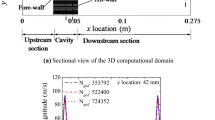Abstract
An experimental and computational investigation has been performed to investigate flow characteristics and flow-field structures for three types of rectangular cavities. The data presented herein was obtained with cavity length to depth ratio of 6, 10 and 15 at 0° of attack, yawing and rolling angles of 0° over free-stream Mach numbers of 0.6, 0.8, 1.2 and 1.5 at Reynolds numbers of 1.23 ×107, 1.55 ×107, 2.01 ×107 and 2.26 ×107 per meter. The results indicate that the shear-layer expands over the cavity leading edge and impinges on the cavity floor for closed cavity flow, whereas it bridges the open cavity. The static pressure distributions are relatively uniform with the exception of a small adverse gradient occurring ahead of the rear face inside open cavity. Cavity length to depth ratio is a key geometrical parameter to define cavity flow types and influent pressure distributions inside cavities, and its decrease induces a decrease in pressure gradient. Increase in free-stream Mach numbers results in the trend that cavity flow types transform from closed to transitional cavity flow and from transitional to open cavity flow.
Similar content being viewed by others
References
Stallings, R.L. Jr.: Store separation from cavity at supersonic flight speeds. Spacecraft 20(2) (1983)
Plentovich, E.B.: Three-dimensional cavity flow fields at subsonic and transonic speeds. NASA Tech. Memo. 4209 (1990)
Stallings, R.L. Jr., Wilcox, F.J. Jr., Forrest, D.K.: Measurements of forces, moments, and pressures on a generic store separating from a box cavity at supersonic speeds. NASA TP 3110 (1991)
Tracy, M.B., Plentovich, E.B.: Characterization of cavity flow fields using pressure date obtained in the Langley 0.3-meter transonic cryogenic tunnel. NASA Tech. Memo. 4436 (1993)
Plentovich, E.B., et al.: Test cavity pressure measurements at subsonic and transonic speeds. NASA Tech. Pap. 3358 (1993)
Pereira, J.C.: Test and numerical investigation of flow oscillations in a rectangular cavity. Trans ASM 117 (1995)
Murray, R., Elliott, G.S.: The Compressible Shear Layer over a Two-Dimensional Cavity. American of Aeronautics and Astronautics Inc. (1997)
Lillberg, E., Fureby, C.: Large eddy simulations of supersonic cavity flow. AIAA Pap. 2000-2411
Ching-Wei, M.S., Philip, J.M.: Comparison of two-and-three-dimensional turbulent cavity flows. AIAA Pap. 2001-0511
Hamed, A., Basu, D., Das, K.: Detached eddy simulations of supersonic flow over cavity. AIAA Pap. 2003-549
Aradag, S., Knight, D.D.: Simulation of supersonic cavity flow using 3D RANS equations. AIAA Pap. 2004-4966
Wilcox, D.C.: Turbulence Modeling for CFD. DCW Industries, La Canada (1993)
Rodi, W., Scheuerer, G.: Calculation of heat transfer to convection-cooled gas turbine blades. J. Eng. Gas Turbine Power 17, 620–627 (1985)
Author information
Authors and Affiliations
Corresponding author
Rights and permissions
About this article
Cite this article
Yang, D., Li, J., Fan, Z. et al. Aerodynamic Characteristics of Transonic and Supersonic Flow over Rectangular Cavities. Flow Turbulence Combust 84, 639–652 (2010). https://doi.org/10.1007/s10494-010-9246-7
Received:
Accepted:
Published:
Issue Date:
DOI: https://doi.org/10.1007/s10494-010-9246-7




